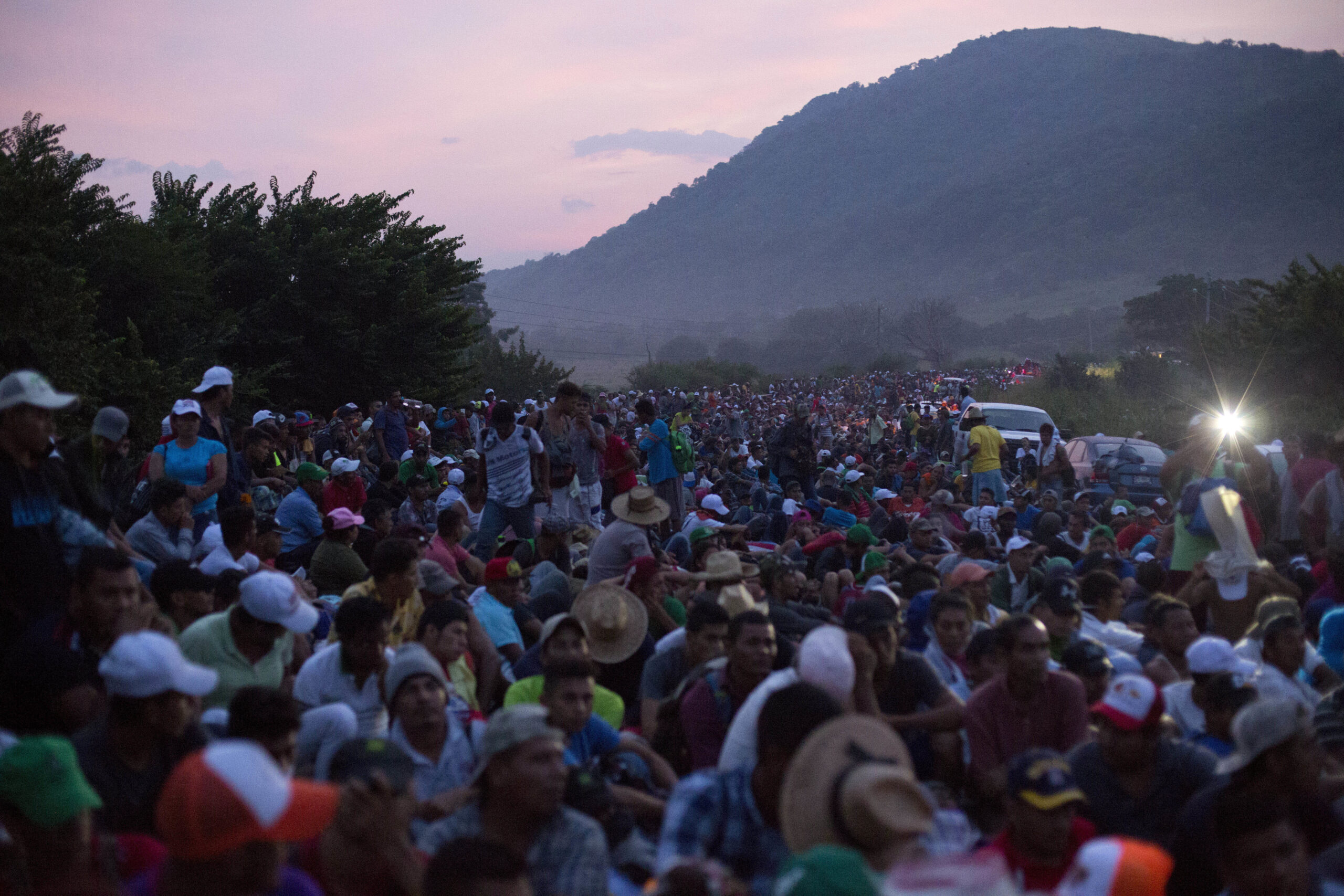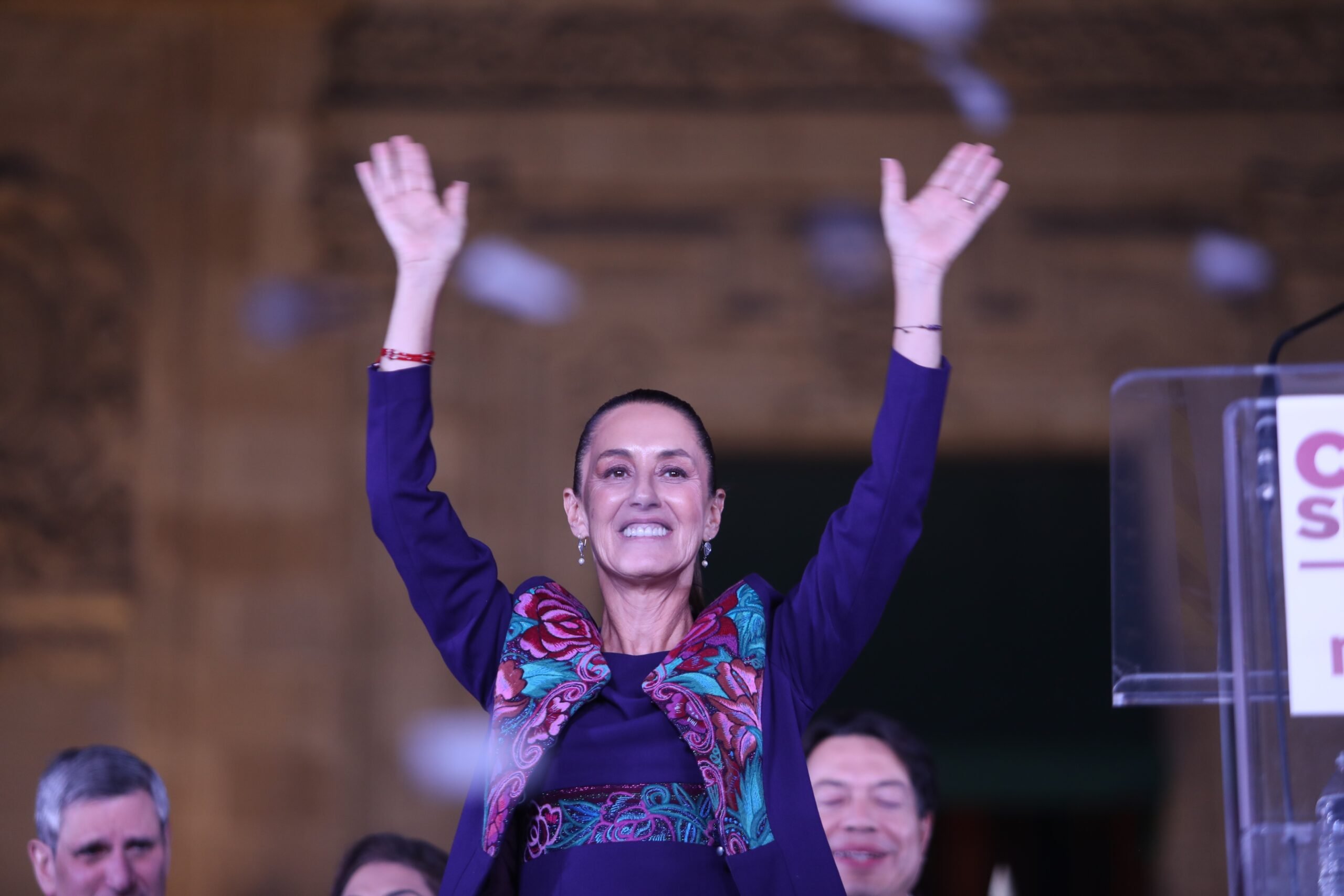On June 2, Claudia Sheinbaum from the governing Morena Party won Mexico’s presidential election in a landslide, setting her up to become the country’s first woman president in October. A former mayor of Mexico City and an engineer, her victory is being widely hailed as a turning point for the country. Despite the accolades, the sobering reality is that Mexico’s harmful migration policies are likely to continue. President Andrés Manuel López Obrador (AMLO), who is ending his six-year term, did not meet progressive expectations for a humanitarian approach to this issue. Instead, he embraced a militarized approach, which all indications show his successor intends to maintain.
During his 2018 presidential bid, AMLO campaigned against U.S. President Donald Trump’s anti-immigrant policies and rhetoric, aiming to position himself as a champion of migrant rights. He published a book, Oye, Trump, to protest the wall. At first, he followed through. While talking about the government’s approach to migration, AMLO’s secretary of the interior, Olga Sánchez Cordero, stressed that migration policy would be based on two axes: the protection of the rights of migrants and development cooperation with Central American countries. Sánchez Cordero announced a full restructuring of Mexico’s Instituto Nacional de Migración (INM) so that “migrants are not criminalized,” and a record number of humanitarian visas were subsequently issued.
However, this stance was dropped in 2019 after Trump threatened to impose tariffs on goods if the Mexican government didn’t take action to curb migration. Fearing a trade war, AMLO gave in to Trump’s demands. He agreed to let Trump bounce vulnerable asylum-seekers back into dangerous Mexican border towns to await far-off U.S. court dates, and he deployed Mexico’s National Guard to the country’s border with Guatemala. He also appointed Francisco Garduño, who had previously been in charge of prison policy, as the new head of INM, confirming the securitization of migration policy that has now been in place for the past 5 years.
Sheinbaum ran on a platform of continuity, and the election was considered a referendum on AMLO’s political project. Although she rarely discussed foreign policy, Sheinbaum consistently echoed AMLO’s positions when questioned directly. She did not offer original ideas or commit to making changes to migration policy. At the presidential debates, she avoided giving even the slightest criticism of AMLO’s migration policy. Like AMLO, she argued for a long-term strategy that addresses the root causes of migration, poverty, and violence, but no immediate solutions were offered for migrants in Mexican territory who are often preyed on by the cartels.
Isabel Gil Everaert, a sociologist at the National Autonomous University of Mexico, examined Sheinbaum’s electoral platform and found few mentions of migration in the document, as well as a refusal to acknowledge the new complexities of the issue, with Mexico becoming the destination “elected by or imposed on” many migrants. Sheinbaum’s espoused view during the campaign that “Ultimately, migrants want to go to the U.S.” conveniently distances Mexico from its human rights responsibilities—especially if she continues to comply with U.S. dictates to bottle up migrants south of the Rio Grande.
Mexico’s current migration policy is characterized by militarization and human rights violations. During their journey north, migrants are subject to kidnapping and violence by cartel members, along with arbitrary containment, detention, and expulsion by Mexican authorities—currently at the behest of President Joe Biden’s administration. Further migrant crackdowns are expected over the next few months as Biden campaigns for reelection and demands more cooperation from the Mexican government to keep the numbers down at the border.
“These are very violent arrests that undermine people’s dignity and clearly violate their human rights,” said Alberto Xiconténcatl Carrasco, director of Casa del Migrante de Saltillo—a migrant shelter—in the northern border state of Coahuila.

In order to avoid being rounded up by Mexican authorities and bused back to the southern border—a controversial program that the government has publicly acknowledged—migrants resort to traffickers, increasing the cost and risk of their journey. Migrants have also adapted their routes, jumping on trains or walking through difficult terrain. “Not everyone makes it,” said Carrasco. “The stories we hear from people who have managed to reach Ciudad Juárez are that many are intercepted along the way by Mexican immigration authorities. Migrant kidnappings also occur in certain zones.”
Those seeking asylum do not fare better than economic migrants. The backlog of asylum applications in the United States, along with shifting asylum policies, has been forcing migrants to wait for prolonged periods of time just south of the U.S. border. In March 2023, a fire at the prison-like estación migratoria of INM in Ciudad Juárez resulted in the deaths of 40 migrants and the injury of at least 26 others. An academic and former head of INM, Tonatiuh Guillén López, has argued that a policy that prioritizes people’s lives could have prevented the tragedy: “The Mexican State cannot avoid direct responsibility for this crime, given that the deaths occurred within its facilities, during the (abusive) exercise of migratory functions, and within the framework of a severe, militarized immigration policy,” he wrote for the news outlet Nodal. To date, the government has provided compensation to some of the families of those lost in the fire, but INM head Garduño has been shielded from accountability.
One cannot overstate the U.S.’s influence on AMLO’s migration policy. Both the Trump and Biden administrations have pressured Mexico into controlling migration flows. With Trump, the pressure on migration was direct and aggressive. According to Gil Guerra, an immigration policy analyst at the Niskanen Center, “The Trump administration made it clear to AMLO and [Former President Enrique] Peña Nieto before him that getting migration and the border under control was more of a priority” than other important issues on the bilateral agenda.
AMLO’s compliance with Trump’s demands on migration opened the way for a pragmatic and publicly amiable understanding between the two governments, culminating in AMLO’s visit to the White House in July 2020 after a new free trade agreement between the United States, Canada, and Mexico came into force. In a move that baffled observers, AMLO thanked Trump for not imposing anything on Mexico and even called him a friend.
Despite previously pledging to roll back Trump’s anti-immigration measures, Biden, after taking office, pressured Mexico into keeping its existing migration policy. Biden took early steps to halt the construction of the border wall and restart the processing of green cards, but a post-pandemic migration surge and the fear of appearing unable to control the border caused him to adjust his approach. As Gema Kloppe-Santamaría, professor of U.S.-Latin American relations at George Washington University, explained, “Biden has continued with a very restrictive immigration policy, asking Mexico to cooperate by acting as another border for the United States.” In Mexico, this cooperation has resulted in increased military involvement in managing migration and more human rights violations.
“There’s complete alignment on what we have to do with respect to how we conceptually address a problem. The first is root causes. … People want to stay where they are, but they’re driven out because of poverty and political issues,” said Biden’s ambassador to Mexico, Ken Salazar, in his first public remarks after Sheinbaum’s victory. Mirroring former President Barack Obama’s “Alliance for Prosperity” development program, the Biden administration provided over $1 billion in fiscal year 2022 to address the root causes of migration in Central America. Such aid is often politically contentious in Congress, and the dollar amounts are dwarfed by the remittances that migrant workers, legal and otherwise, send home from the States. Democrats tend to use these aid packages as a fig leaf for migrant crackdowns.
Experts predict that with Sheinbaum, Mexico’s migration policy will stay as it is now, no matter who wins the U.S. election in November. Like AMLO, she “has shown no disposition” to confront the United States or deny its requests, concluded Carrasco. What’s more, AMLO has confirmed there are advantages to be had in exploiting the U.S. dependence on Mexico’s cooperation in migration, such as fending off criticisms of the Morena government’s positions on other issues. “AMLO’s management of migrant flows remains pivotal for U.S. expectations,” contended Guerra from the Niskanen Center. Though activists in Mexico have constantly denounced the government’s handling of the issue, the topic has remained peripheral in the national conversation. AMLO and Sheinbaum’s political party has yet to pay any electoral price for human rights violations derived from this approach.
Diana Alarcón, International Affairs Coordinator for Sheinbaum’s Dialogos por la Transformación team, confirmed that regarding migration policy, Sheinbaum’s vision is in line with AMLO’s. “[Sheinbaum’s government will be] consolidating what has been started in this government,” namely “addressing the causes of migration and why people leave their communities.” Alarcón said that reinforcing interinstitutional coordination mechanisms is part of the agenda. But no specific plans have been announced to reverse the militarization of migration policy or to overhaul the much-criticized INM.
Biden’s recent push for even more restrictions on asylum at the U.S.-Mexico border signals that pressures will keep mounting on the Mexican government as immigration remains a top electoral issue.
“Sheinbaum inherits a volatile migration landscape, and if the focus continues to be on control, militarization, and securitization of immigration policy, we will see more human rights violations,” observed Kloppe-Santamaría. It does appear that AMLO’s shift in migration policy has become entrenched. As Sheinbaum takes office, human rights advocates on both sides of the border will have their work cut out for them trying to stop migrants’ lives from being used as a bargaining chip between the Mexican and U.S. governments.


